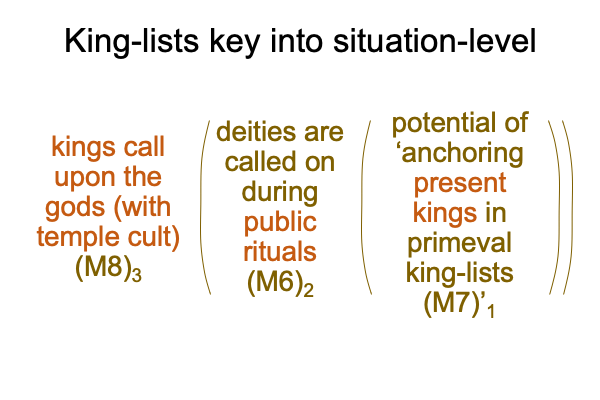0087 For example, Genesis genealogies resonate with various Sumerian, Akkadian and Babylonian king lists. The term, “resonate”? Think “re-” (again) and “-sonate” (sound).
0088 These king-lists key into the situation level of the myth interscope.

0088 The situation-level potential situates the entire content level, where divine-nature correspondences2a emerge from (and situate) the potential of fantastical elements1a, in the normal context of a primeval age3a. The genealogies and the king lists1b are scaffolding that are situated by a perception that the gods2b (or God2b) live, today, as well as in distant times. The perception2b that the character of the gods2b has always been operational since the beginning1b is itself a ritual association3b.
0089 The content level says, “This is our story.”
The situation level says, “Our story brings the past into the present and the present into the past.”
Both Genesis 2.4-11 and the origin stories of the ancient Near East are mytho-historical texts that address the same prehistoric drama. They represent two trajectories within one multifaceted sequence of events, occurring before history can be written, because writing is yet to be invented. Writing starts during the Uruk. At first, writing is used record economic transactions. Hundreds of years later, the Sumerians write their origin myths onto clay tablets.
0090 In Part Two, Craig demonstrates that the mytho-historical stories of Genesis 2:4-11 apply to events associated to the Ubaid, Uruk and Sumerian archaeological periods.
But, in Part Three, Craig locates the historical Adam with the ancient hominin species, Homo heidelbergensis.
0091 With that in mind, allow me to restate the question posed in point 0039.
Why do Genesis 2:4-4 and all other origin stories of ancient Mesopotamia describe a recent creation of humans?
Why do they only describe our current Lebenswelt?
Why can’t they acknowledge the Lebenswelt that we evolved in?
0092 The answer is obvious.
Our current Lebenswelt cannot see into the Lebenswelt that we evolved in.
The storytellers cannot see beyond the horizon of the first singularity.
This answer also appears in Comments on Daniel Houck’s Book (2020) “Aquinas, Original Sin and the Challenge of Evolution, by Razie Mah, available at smashwords and other e-book venues.
